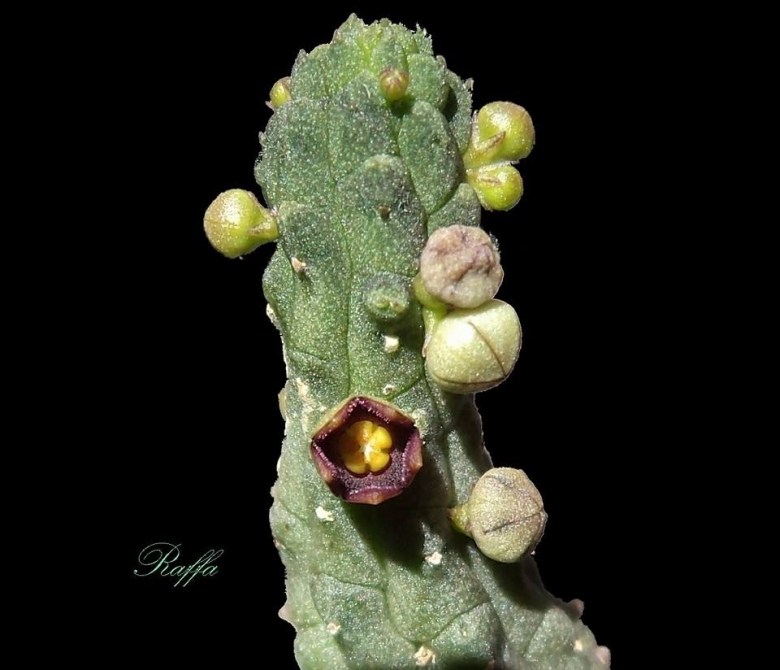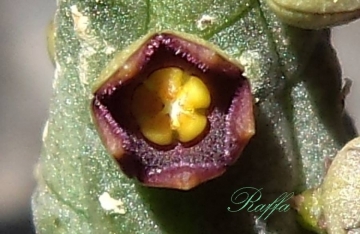Accepted Scientific Name: Echidnopsis cereiformis Hook.f.
Bot. Mag. 97: t. 5930. 1871

Echidnopsis cereiformis var. obscura Photo by: Raffa C. Garcia
This variety has flowers of an intense purplish-brown.
Origin and Habitat: Eritrea Nile Land Schweinfurth (ex Berger).
Synonyms:
See all synonyms of Echidnopsis cereiformis
Description: Echidnopsis cereiformisSN|18992]]SN|18992]] var. obscura is a dark flowered variety of Echidnopsis cereiformisSN|18992]]SN|18992]] with tiny deep brown flowers that sprout out of the entire length of each stem but mainly toward the tip in autumn. The var. obscura often mentioned in literature and sometimes offered in plant lists, should be fully synonymized with the type variety.
Habit: It is a small snake-like succulent with thin tufted cylindrical branches (as implied in its generic name which means “viper-like”). It is named “cereiformis” from its cactus-like appearance (also a good mimic of stems of Euphorbia mamillaris).
Stems: 7-30 cm (often up to 60) cm long. reclining to upright, leafless, green, dull dark green, brownish-green or reddish, rooted on the under side, round, with flatfish, tasselled ribs divided into 6-10 (usually 8) rows of broadly hexagonal, oblong, flat tubercles (podaria) each with a white central papilla (the remains of an undeveloped leaf), of a uniform bright green, firm consistence, papillose and faintly wrinkled surface. Buds from the transverse depressions on the ribs.
Roots: fibrous.
Leaves: Tiny, rudimentary, triangular, thick, finely papillose, ascending, very early Falling, borne on tubercles.
Flowers: Very small, fascicled, sessile, deep brown-purple produced near the stems summits. Corolla campanulate 3-8 mm across, inner surface usually hairless, brown-purple to red-brown, outer surface dull yellow, brownish or purplish. Calyx tube, hemispheric. Lobes 5 triangular, acute, erect to slightly diverging, valvate. Corona bright yellow, outer lobes reduced to linear or triangular teeth in gaps between inner lobes or absent. Pollinia erect, globose, yellow.
Blooming season: Late summer to autumn.
Bibliography: Major references and further lectures
1) N. E. Brown.“Flora of Tropical Africa” Vol 4, Part 1, page 231, 1904
2) Focke Albers, Ulrich Meve “Illustrated Handbook of Succulent Plants: Asclepiadaceae: Asclepiadaceae” Volume 4 Springer Science & Business Media, 2002
 Echidnopsis cereiformis var. obscura Photo by: Raffa C. Garcia
Echidnopsis cereiformis var. obscura Photo by: Raffa C. GarciaSend a photo of this plant.The gallery now contains thousands of pictures, however it is possible to do even more. We are, of course, seeking photos of species not yet shown in the gallery but not only that, we are also looking for better pictures than those already present.
Read More... Cultivation and Propagation: Echidnopsis cereiformisSN|18992]]SN|18992]] is an easy obliging blooming plant, which is happy in any average succulent house. This plant is common to warrant any description, let it suffice to say that this plant is easy to grow and flower, and one which will tolerate most soils and growing conditions.
Soil: Since roots are quite shallow, use a cactus mix or add extra perlite or pumice to regular soil potting soil. A gritty, very free-draining compost is suitable, and clay pots help the plants to dry out between watering.
Watering: They require moderately watering through the growing season but enjoy plenty of water and some fertiliser in hot weather, this helps them to flower freely. Water more sparingly in winter according to temperatures. But, as with most asclepiads, it is unwise to leave them wet in cold weather.
Hardiness: Winter care presents no problems at 5°C with plenty of light.
Sun Exposure: Partial sun or light shade.
Pest and diseases: They are generally fairly easy to grow, especially if kept pest-free. They are susceptible to stem and root mealy bugs, and damage from these may well initiate fungal attack. If you do have problems with a stem or with basal rotting, you can reliably isolate the healthy parts, dry them off, and re-root them in moist compost.
Cultural Practices: Re-pot every 2 years.
Propagation: Easiest with stem cuttings. Allow cuttings to dry a day before planting. Stems must be laid (Not buried) on gritty compost and will then root from the underside of the stems. It can also be increased from seeds sowing in spring in moist, sandy peat moss. Barely cover seeds.











